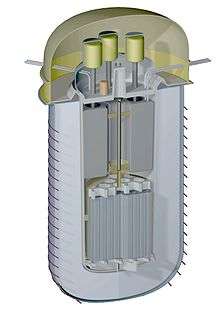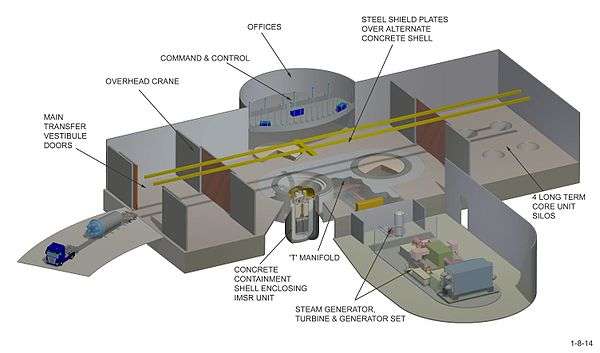IMSR
The Integral Molten Salt Reactor (IMSR) is a small modular reactor (SMR) that employs molten salt reactor technology. Its design is based closely on the DMSR design from Oak Ridge National Laboratory, TN, USA and incorporates elements found in the SmAHTR, a later design from the same laboratory. The IMSR is being developed by Terrestrial Energy Inc. (TEI),[1] headquartered in Oakville, Canada. The IMSR belongs to the DMSR class of MSR and hence is "burner" reactor that employs a liquid fuel rather than a conventional solid fuel; this liquid contains the nuclear fuel and also serves as primary coolant.
Design

The IMSR "integrates" into a compact, sealed and replaceable nuclear reactor unit (the IMSR Core-unit) all the primary components of the nuclear reactor that operate on the liquid molten fluoride salt fuel: moderator, primary heat exchangers, pumps and control rods.
The IMSR belongs to the DMSR[2] class of MSR. It therefore employs a uranium dominant fuel with a simple converter (also known as a "burner") fuel cycle objective. This is unlike the majority of molten salt reactor designs that employ thorium, which requires the more complex breeder objective. The design uses low enriched uranium fuel, as do most operating power reactors. The IMSR fuel is uranium tetrafluoride (UF4). This fuel is blended with carrier salts, which are also fluorides, such as lithium fluoride (LiF), sodium fluoride (NaF) and/or beryllium fluoride (BeF2). These carrier salts increase the heat capacity of the fuel (coolant) and lower the fuel's melting point.
This liquid fuel-coolant mixture is pumped through a nuclear reactor core that is moderated by graphite elements, making this a thermal neutron reactor. After heating up in the core, pumps force the liquid fuel through heat exchangers positioned inside the reactor vessel. All the primary components, heat exchangers etc. are positioned inside the reactor vessel. The reactor’s integrated architecture avoids the use of external piping for the fuel that could leak or break.
The piping external to the reactor vessel contains a secondary, nonradioactive coolant salt. This salt acts as an additional containment barrier and heat sink, and transfers its energy to either a standard industrial grade steam turbine plant, which generates electricity or to a process heat application, or to a combination of the two.
The IMSR Core-unit is designed to be fully replaceable in normal operation. During operation, small fresh fuel/salt batches are periodically melted and added to the reactor system. This online refueling process does not require the mechanical refueling machinery required for solid fuel reactor systems.
These design features are based on two previous molten salt designs from Oak Ridge National Laboratory (ORNL) – the ORNL denatured molten salt reactor (DMSR) from 1980 and the solid fuel/liquid salt cooled, small modular advanced high temperature reactor (SmAHTR), a 2010 design. The DMSR, as carried into the IMSR design, proposed to use molten salt fuel and graphite moderator in a simplified converter design using LEU (in combination with thorium, which may be used in the IMSR), with periodic additions of LEU fuel. Most previous proposals for molten salt reactors all bred more fuel than needed to operate, so were called breeders. Converter or "burner" reactors like the IMSR and DMSR can also utilize plutonium from existing spent fuel as their makeup fuel source. The more recent SmAHTR proposal was for a small, modular, molten salt cooled but solid TRISO fuelled reactor.[3]
Terrestrial Energy
Terrestrial Energy is currently working on 3 different designs, 80 megawatts-thermal (MWth), 300 MWth and 600 MWth, generating 33, 141, and 291 megawatts (MWe) of electricity respectively, using standard industrial grade steam turbines. As standard industrial grade steam turbines are used, cogeneration, or combined heat and power, is also possible.
TEI’s goal is to have the IMSR licensed and ready for commercial rollout by the early 2020s.

Replaceable core-unit
The design uses a replaceable core-unit.[4] When the graphite moderators lifetime exposure to neutron flux causes it to start distorting beyond acceptable limits then rather than remove and replace the graphite moderator the entire IMSR core-unit is replaced as a unit. This includes the pumps, pump motors, control rod, heat exchangers and graphite moderator, all of which are either inside the vessel or directly attached to it. To facilitate a replacement, the design employs two reactor silos in the reactor building, one operating and one idle or in cool-down. After 7 years of operation, the core-unit is shut down and cools in place to allow short lived radionuclides to decay. After that cool-down period, the spent core-unit is lifted out and eventually replaced.
Simultaneously, the core-unit is activated in the second silo. This entails connection to the secondary (coolant) salt piping, placement of the containment head and biological shield and loading with fresh fuel salt. The containment head provides double containment (the first being the sealed reactor vessel itself). The new core-unit can now start its 7 years of power operations.
The IMSR vendor accumulates sealed, spent IMSR core-units and spent fuel salt tanks in onsite, below grade silos. This operational mode reduces uncertainties with respect to long term service life of materials and equipment, replacing them by design rather than allowing age-related issues such as creep or corrosion to accumulate.
Online refueling
The IMSR employs online refueling. While operating, small fresh fuel salt batches are periodically melted and added to the reactor system. As the reactor is liquid fueled this process does not require mechanical refueling machinery. The reactor vessel is never opened, thereby ensuring a clean operating environment.
Safety
Nuclear power reactors have three fundamental safety requirements:
- Control
- Cooling
- Containment
Control
Nuclear reactors require control over the critical nuclear chain reaction. As such, the design must provide for exact control over the reaction rate of the core, and must enable reliable shut-down when needed. Under routine operations, the IMSR relies on intrinsic stability for reactivity control. This behavior is known as negative power feedback - the reactor is self-stabilizing in power output and temperature, and is characterized as a load-following reactor. As backup, the IMSR employs a flow-driven control rod, which sinks into the core if pumped flow is lost. A second backup is provided in the form of a meltable can placed inside the IMSR Core-unit that is filled with a very strong neutron absorber that melts and permanently shuts down the core-unit if overheating occurs.
Cooling
A nuclear reactor is a thermal power system — it generates heat, transports it and eventually converts it to motion in a heat engine, in this case a steam turbine. Such systems require that the heat is removed, transported and converted at the same rate it is generated.
A fundamental issue for nuclear reactors is that even when the nuclear fission process is halted, heat continues to be generated at significant levels by the radioactive decay of the fission products for days and even months. This is known as decay heat and is the major safety driver behind the cooling of nuclear reactors, because this decay heat must be removed. For conventional light water reactors, in all foreseeable circumstances, the flow of cooling water must continue. Otherwise damage and melting of the (solid) fuel can result. Light water reactors operate with a volatile coolant, requiring high pressure operation and depressurization in an emergency.
The IMSR instead uses liquid fuel at low pressure. IMSR does not rely on bringing coolant to the reactor or depressurizing the reactor. IMSR cooling is passive. Heat continuously dissipates from the core-unit. During normal operation, heat loss is reduced by the use of meltable insulation, in the form of a normally solid buffer salt. The buffer salt is placed in an annular tank enveloping the reactor on all sides except the top. Upon shutdown of the primary salt pumps, the reactor passively shuts down. It can still heat up slowly by the small but constant decay heat as previously described. This heatup melts the buffer salt, thereby initially absorbing decay heat through the latent heat of fusion, then providing convection cooling through the liquidified buffer salt. On the outside of the annular buffer salt tank, are a series of water-filled cooling pipes. This is the so-called cooling jacket. The melted buffer salt exerts much less thermal resistance, and becomes a natural convection coolant that transports heat to the jacket. This causes the cooling jacket water to evaporate. The jacket contains sufficient water for more than 7 days of evaporative cooling. Beyond that period, heat losses to the air and ground match decay heat generation, without replenishing the cooling water supply. The thermal dynamics and inertia of the entire system of the core-unit in its containment silo is sufficient to absorb and disperse decay heat.
Containment
All molten salt reactors have features that contribute to containment safety. These mostly have to do with the properties of the salt itself. The salts are chemically inert. They do not burn and are not combustible. The salts have low volatility (high boiling point around 1400 °C), allowing a low operating pressure of the core and cooling loops. This provides a large margin above the normal operating temperature of some 600 to 700 °C. This makes it possible to operate at low pressures without risk of coolant/fuel boiling.
The high chemical stability of the salt precludes energetic chemical reactions such as hydrogen gas generation/detonation and sodium combustion, that can challenge the design and operations of other reactor types. The fluoride salt reacts with many fission products to produce chemically stable, non-volatile fluorides, such as cesium fluoride. Similarly, other high risk fission products such as iodine, dissolve into the fuel salt, bound up iodide salt.[5] See liquid fluoride thorium reactor and molten salt reactor for more information.
The IMSR also has multiple physical containment barriers. It uses a sealed, integral reactor unit. The core-unit is surrounded by the buffer salt tank, itself a sealed unit surrounded by structural steel and concrete. The core-unit is covered up from the top by a steel containment head which is itself covered by thick round steel plates. The plates serve as radiation shield and provides protection against external hazards such as explosions or aircraft crash penetration. The reactor building provides an additional layer of protection against such external hazards, as well as a controlled, filtered-air confinement area.
Most molten salt reactors use a gravity drain tank as an emergency storage reservoir for the molten fuel salt. The IMSR deliberately avoids this drain tank which has safety problems. The IMSR design is simpler and eliminates the drain line and accompanying risks from low level vessel penetrations. The result is a more compact, robust design with fewer parts and few failure scenarios.
References
- ↑ "Terrestrial Energy Inc.".
- ↑ Engel,, J.R.; Grimes,, W.W.; Bauman,, H.F.; McCoy, H.E.; Bearing, J.F.; Rhoades, W.A. "Conceptual design characteristics of a denatured molten salt reactor with once-through fueling" (PDF). ORNL-TM-7207.
- ↑ "SmAHTR presentation by Sherrell Greene" (PDF).
- ↑ John Laurie (2016-05-07), IMSR animation, retrieved 2016-06-30
- ↑ "Fission product behavior in the MSRE" (PDF).
Further reading
- Peter Kelly-Detwiler. "Molten Salt Nuclear Reactors: Part Of America's Long-Term Energy Future?". Forbes.
- "Business focused approach to molten salt reactors".
- "Integral Molten Salt Reactor" (PDF). Nuclear News. American Nuclear Society. December 2014.